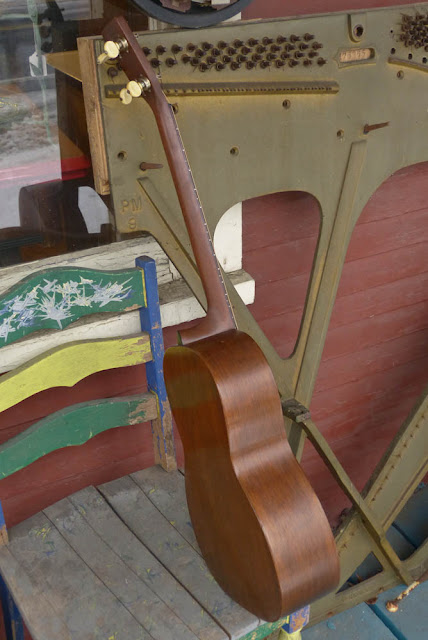1930 Martin 5-17T Tenor Guitar
Update: Per request, I added a second soundclip of this instrument strung lower in GDAE tuning.
I have a soft spot for mahogany-topped Martins. This 5-17T is a fiery little thing and came in pretty close to spec as far as playability was concerned... but did need a fret level/dress, two 3" hairline cracks cleated/filled, a bit of compensation added to the saddle, new pins, and a good setup. After all the adjustments, too, its volume jumped right up and the tone rounded-up with a bit more lower-mids and overall punch. I love how that happens.
I think these earlier, banjo-peg-equipped size 5 tenors are probably the friendliest small-body tenors made. They're easy on the eye and easy on the lap, but were definitely intended for CGDA tuning (or DGBE, for that matter). I'm not a fan of these tuned to octave-mandolin GDAE range as the bass is a bit too tight -- but in the higher, more standard, tunings chords gel into a nice thick bite and lead work sounds smooth and saucy.
The body is 11 1/4" across the lower bout and it has a 22 7/8" scale length. I've currently strung it 30w, 22w, 16, 12 for DGBE tuning. It's all-original save for a new set of ebony bridge pins and endpin.
1 3/16" ebony nut, rosewood headstock veneer, and classy old two-tab geared banjo pegs...
The rosewood board has those cream "micro dots" and the original bar frets -- which were full height and have plenty of height left. My level/dress job was quite light.
The only nod to decoration is the one-ring rosette.
The bridge is good to go and before I set this up I filled/redrilled the pinholes to seat the ball-ends nice and pat. The saddle is now compensated for two-wound/two-plain stringing.
The saddle was its full original height when it got here and remains so. This is what these bridges look like as-original. In old-time and bluegrass circles there's a tendency to want really tall bridges and saddles -- things that most old guitars never had originally.
I consider it mostly a "feel" preference compared to a tonal superiority preference. As far as I'm concerned, the most important element in coaxing power from any pin-bridge guitar is to have decent back-angle behind the saddle so the strings drive the top in a "wave" motion more efficiently.
I consider it mostly a "feel" preference compared to a tonal superiority preference. As far as I'm concerned, the most important element in coaxing power from any pin-bridge guitar is to have decent back-angle behind the saddle so the strings drive the top in a "wave" motion more efficiently.
The satin finish is in really good shape but does have a few places where it's been polished-up from use-wear -- pretty typical.
The Grover two-tab geared pegs (with ivoroid buttons) make tuning much less of a chore vs. standard friction pegs. They hold just fine.
Here's one of the two 3" hairline cracks -- this one was actually quite tight but had some run-out on the top of the wood so it looks wider than it is (it's hard to see it in other pics, no?) -- it's cleated/filled and good to go.
The other one is a tight one on the back that's also cleated.
It comes with a size 5 (or mini-Martin?) Martin gigbag.
























Comments